Behavior of Sedimentary Rock Tunnel against Rigid Projectile Impact
Abstract
1. Introduction
2. Impact Loading Simulation
2.1. Geometry
2.2. Input Properties of Materials
2.3. Meshing, Loading, Boundary and Interaction Conditions
3. Validation of Dynamic Loading
4. Results and Discussion
5. Conclusions
- The Kota sandstone has 2.22-times, 0.77-times, 0.35-times more impact resistance than Jhingurda, Singrauli and Jamrani sandstone, respectively. Therefore, the impact resistance of a rock tunnel is a function of cohesion and friction angle.
- The deformation profile for Jhingurda sandstone follows a smooth curvature while the curvature becomes distorted and non-uniform for other types of sandstone. It has also been observed that as the strength of sandstone increases, the peak deformation decreases, while the length of tunnel under disturbance increases with the increase in the strength of sandstone. In addition, it has been concluded that weaker sandstone requires strengthening for a smaller area after an impact loading event while high-strength sandstone will require repair for a longer portion of the tunnel.
- The magnitude of peak velocity and acceleration is maximum in case of Jhingurda sandstone at 20.41 milliseconds. Moreover, the pattern of variation in acceleration and velocity remains similar, and therefore, it is independent of the type of sandstone.
- It can be concluded that Kota sandstone has minimum deformation and is therefore the safest sandstone rock under impact loading conditions. However, the area of disturbance is greatest in the case of Kota sandstone, and vibrations may reach the tunnel crown in a shorter time in comparison to other rocks.
- The effect of impact loading has reached the tunnel lining when constructed in strong and brittle sandstone, or vice versa. In addition, the tensile damage in all the different types of sandstones considered in the present study remains concentrated at the outer periphery of the liner. The steel reinforcement cage experiences maximum deformation at the crown position in all the cases, while the maximum magnitude of deformation occurred in the case of Jhingurda sandstone.
Author Contributions
Funding
Institutional Review Board Statement
Informed Consent Statement
Data Availability Statement
Acknowledgments
Conflicts of Interest
References
- Do, N.A.; Oreste, P.; Dias, D.; Antonello, C.; Djeran-Maigre, I.; Livio, L. Stress and strain state in the segmental linings during mechanized tunnelling. Geomech. Eng. 2014, 7, 75–85. [Google Scholar] [CrossRef]
- Do, N.A.; Dias, D.; Oreste, P.; Djeran-Maigre, I. 2D numerical investigations of twin tunnel interaction. Geomech. Eng. 2014, 6, 263–275. [Google Scholar] [CrossRef]
- Eskandari, F.; Goharrizi, K.G.; Hooti, A. The impact of EPB pressure on surface settlement and face displacement in intersection of triple tunnels at Mashhad metro. Geomech. Eng. 2018, 15, 769–774. [Google Scholar] [CrossRef]
- Ghasemi, S.H.; Nowak, A.S. Reliability analysis of circular tunnel with consideration of the strength limit state. Geomech. Eng. 2018, 15, 879–888. [Google Scholar] [CrossRef]
- Mazek, S.A. Evaluation of surface displacement equation due to tunnelling in cohesionless soil. Geomech. Eng. 2014, 7, 55–73. [Google Scholar] [CrossRef]
- Miranda, T.; Dias, D.; Pinheiro, M.; Eclaircy-Caudron, S. Methodology for real-time adaptation of tunnels support using the observational method. Geomech. Eng. 2015, 8, 153–171. [Google Scholar] [CrossRef]
- Fahimifar, A.; Ghadami, H.; Ahmadvand, M. The ground response curve of underwater tunnels, excavated in a strain-softening rock mass. Geomech. Eng. 2015, 8, 323–359. [Google Scholar] [CrossRef]
- Nawel, B.; Salah, M. Numerical modeling of two parallel tunnels interaction using three-dimensional finite elements method. Geomech. Eng. 2015, 9, 775–791. [Google Scholar] [CrossRef]
- Nikadat, N.; Marji, M.F. Analysis of stress distribution around tunnels by hybridized fsm and ddm considering the influences of joints parameters. Geomech. Eng. 2016, 11, 269–288. [Google Scholar] [CrossRef]
- Khezri, N.; Mohamad, H.; Fatahi, B. Stability assessment of tunnel face in a layered soil using upper bound theorem of limit analysis. Geomech. Eng. 2016, 11, 471–492. [Google Scholar] [CrossRef]
- Aalianvari, A.; Soltani-Mohammadi, S.; Rahemi, Z. Estimation of geomechanical parameters of tunnel route using geostatistical methods. Geomech. Eng. 2018, 14, 453–458. [Google Scholar] [CrossRef]
- Zidan, A.F.; Ramadan, O.M. A hybrid MC-HS model for 3D analysis of tunnelling under piled structures. Geomech. Eng. 2018, 14, 479–489. [Google Scholar] [CrossRef]
- Khan, M.A.; Sadique, M.R.; Harahap, I.H.; Zaid, M.; Alam, M.M. Static and Dynamic Analysis of the Shielded Tunnel in Alluvium Soil with 2D FEM Model. Transp. Infrastruct. Geotechnol. 2022, 9, 73–100. [Google Scholar] [CrossRef]
- Sadique, R.M.; Zaid, M.; Naqvi, M.W.; Akhtar, M.F. Analysis of Underground Renewable Energy Storage Tunnels Subjected to Capricious Superstructures. In Renewable Power for Sustainable Growth, Proceedings of the International Conference on Renewal Power (ICRP 2020), Rajouri, India, 17–18 April 2020; Lecture Notes in Electrical Engineering; Springer: Singapore, 2021; Volume 723. [Google Scholar]
- Sadique, M.R.; Ali, A.; Zaid, M.; Masroor Alam, M. Experimental and Numerical Modeling of Tunneling-Induced Ground Settlement in Clayey Soil. In Advances in Geotechnics and Structural Engineering, Proceedings of the TRACE 2020, Noida, India, 20–21 August 2020; Lecture Notes in Civil Engineering; Springer: Singapore, 2021; Volume 143. [Google Scholar]
- Sadique, M.R.; Zaid, M.; Alam, M.M. Rock Tunnel Performance Under Blast Loading Through Finite Element Analysis. Geotech. Geol. Eng. 2022, 40, 35–56. [Google Scholar] [CrossRef]
- Zaid, M.; Mishra, S. Numerical Analysis of Shallow Tunnels Under Static Loading: A Finite Element Approach. Geotech. Geol. Eng. 2021, 39, 2581–2607. [Google Scholar] [CrossRef]
- Gao, F.; Hou, A.; Yang, X. Numerical Analysis of Dynamic Mechanical Properties for Rock Sample under Strong Impact Loading. Int. J. Inf. Eng. Electron. Bus. 2010, 2, 10–16. [Google Scholar] [CrossRef]
- Aziznejad, S.; Esmaieli, K.; Hadjigeorgiou, J.; Labrie, D. Responses of jointed rock masses subjected to impact loading. J. Rock Mech. Geotech. Eng. 2018, 10, 624–634. [Google Scholar] [CrossRef]
- Zhou, L.; Zhu, Z.; Wang, M.; Ying, P.; Dong, Y. Dynamic propagation behavior of cracks emanating from tunnel edges under impact loads. Soil Dyn. Earthq. Eng. 2018, 105, 119–126. [Google Scholar] [CrossRef]
- Zhou, L.; Zhu, Z.; Dong, Y.; Fan, Y.; Zhou, Q.; Deng, S. The influence of impacting orientations on the failure modes of cracked tunnel. Int. J. Impact Eng. 2019, 125, 134–142. [Google Scholar] [CrossRef]
- Zhou, L.; Zhu, Z.; Dong, Y.; Ying, P.; Wang, M. Study of the fracture behavior of mode I and mixed mode I/II cracks in tunnel under impact loads. Tunn. Undergr. Space Technol. 2019, 84, 11–21. [Google Scholar] [CrossRef]
- Vidanović, N.; Rašuo, B.; Kastratović, G.; Maksimović, S.; Ćurčić, D.; Samardžić, M. Aerodynamic–structural missile fin optimization. Aerosp. Sci. Technol. 2017, 65, 26–45. [Google Scholar] [CrossRef]
- DMRC. Design Specifications of DMRC; DMRC: New Delhi, India, 2015. [Google Scholar]
- Zaid, M. Dynamic stability analysis of rock tunnels subjected to impact loading with varying UCS. Geomech. Eng. 2021, 24, 505–518. [Google Scholar] [CrossRef]
- Zaid, M. Three-dimensional finite element analysis of urban rock tunnel under static loading condition: Effect of the rock weathering. Geomech. Eng. 2021, 25, 99–109. [Google Scholar] [CrossRef]
- Rao, K.; Rao, G.; Ramamurthy, T. Strength Behaviour of Some Indian Sandstones. In Proceedings of the Asian Regional Conference on Geotechnical Problems and Practices in Foundation Engineering, Colombo, Sri Lanka, 25–27 February 1986; pp. 1–6. [Google Scholar]
- Johnson, G.R.; Cook, W.H. A Constitutive modeling and data for metals subjected to large strain rates and high temperatures. In Proceedings of the 7th International Symposium on Ballistics, The Hague, The Netherlands, 19–21 April 1983. [Google Scholar]
- Borvik, T.; Hopperstad, O.S.; Berstad, T.; Langseth, M. A computational model of viscoplasticity and ductile damage for impact and penetration. Eur. J. Mech. A Solids 2001, 20, 685–712. [Google Scholar] [CrossRef]
- Zaid, M.; Rehan Sadique, M. Dynamic analysis of tunnels in western ghats of indian peninsula: Effect of shape and weathering. In Recent Trends in Civil Engineering; Springer: Singapore, 2021; Volume 77. [Google Scholar]
- Zaid, M.; Rehan Sadique, M. A Simple Approximate Simulation Using Coupled Eulerian–Lagrangian (CEL) Simulation in Investigating Effects of Internal Blast in Rock Tunnel. Indian Geotech. J. 2021, 51, 1038–1055. [Google Scholar] [CrossRef]
- Zaid, M.; Shah, I.A. Blast-Resistant Stability Analysis of Triple Tunnel. In Advances in Geotechnics and Structural Engineering, Proceedings of the TRACE 2020, Noida, India, 20–21 August 2020; Lecture Notes in Civil Engineering; Springer: Singapore, 2021; Volume 143. [Google Scholar]
- Zaid, M.; Athar, M.F.; Sadique, M.R. Effect of Rock Weathering on the Seismic Stability of Different Shapes of the Tunnel. In Lecture Notes in Civil Engineering, Proceedings of the Indian Geotechnical Conference, 2019, Surat, India, 19–21 December 2021; Springer: Singapore, 2021; Volume 137. [Google Scholar]
- Zaid, M.; Faraz Athar, M.; Rehan Sadique, M. Interaction of Transmission Tower Footing with Twin Rock Tunnel. In Advances in Geotechnics and Structural Engineering, Proceedings of the TRACE 2020, Noida, India, 20–21 August 2020; Lecture Notes in Civil Engineering; Springer: Singapore, 2021; Volume 143. [Google Scholar]
- Zaid, M.; Naqvi, M.W.; Sadique, M.R. Stability of Arch Tunnel in Different Magnitude of Earthquake with Effect of Weathering in Western Ghats of India. In Lecture Notes in Civil Engineering, Proceedings of the Indian Geotechnical Conference 2019, Surat, India, 19–21 December 2021; Springer: Singapore, 2021; Volume 138. [Google Scholar]
- Zaid, M.; Sadique, M.R.; Alam, M.M. Blast Resistant Analysis of Rock Tunnel Using Abaqus: Effect of Weathering. Geotech. Geol. Eng. 2021, 40, 809–832. [Google Scholar] [CrossRef]
- Zaid, M.; Sadique, M.R.; Alam, M.M. Blast analysis of tunnels in Manhattan-Schist and Quartz-Schist using coupled-Eulerian–Lagrangian method. Innov. Infrastruct. Solut. 2021, 6, 69. [Google Scholar] [CrossRef]
- Zaid, M.; Sadique, M.R. Effect of joint orientation and weathering on static stability of rock slope having transmission tower. In Proceedings of the 7th Indian Young Geotechnical Engineers Conference 2019, Silchar, India, 15–16 March 2019; Volume 5, pp. 414–422. [Google Scholar]
- Zaid, M.; Sadique, M.R. Numerical modelling of internal blast loading on a rock tunnel. Adv. Comput. Des. 2020, 5, 417–443. [Google Scholar] [CrossRef]
- Zaid, M.; Sadique, M.R. The response of rock tunnel when subjected to blast loading: Finite element analysis. Eng. Rep. 2021, 3, e12293. [Google Scholar] [CrossRef]
- Andersson, A. Impact Loading on Concrete Slabs: Experimental Tests and Numerical Simulation; KTH: Stockholm, Sweden, 2014. [Google Scholar]






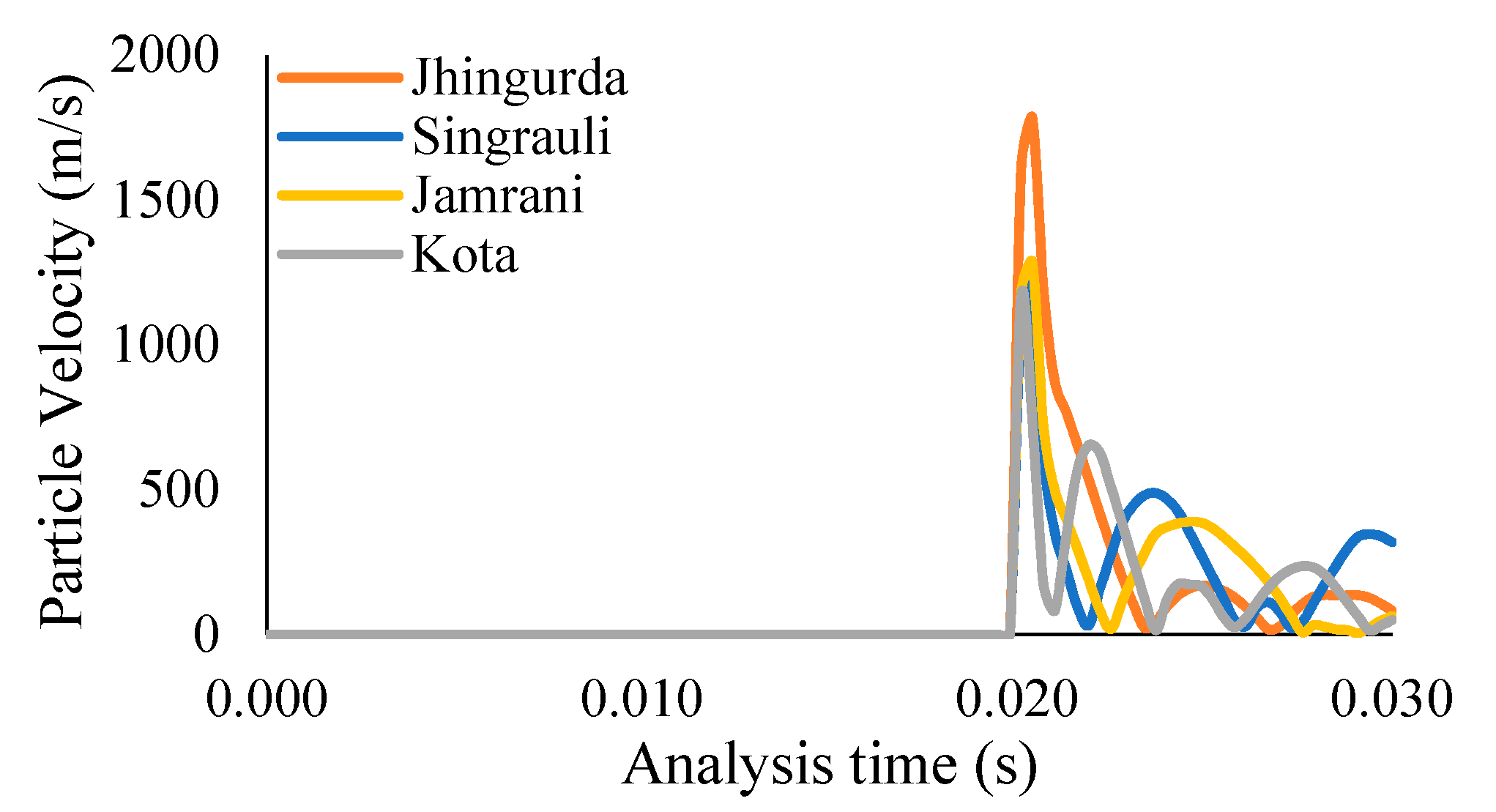
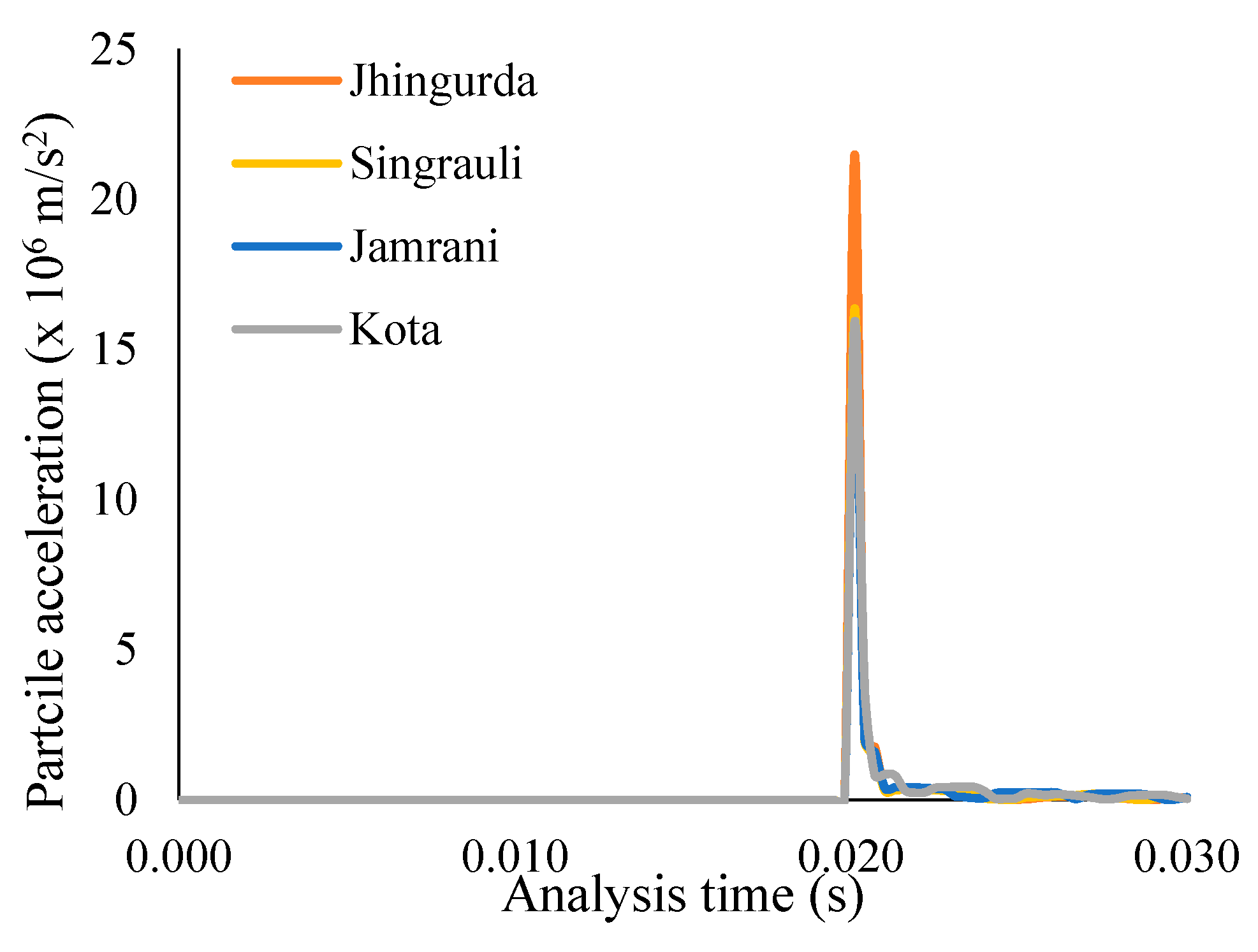
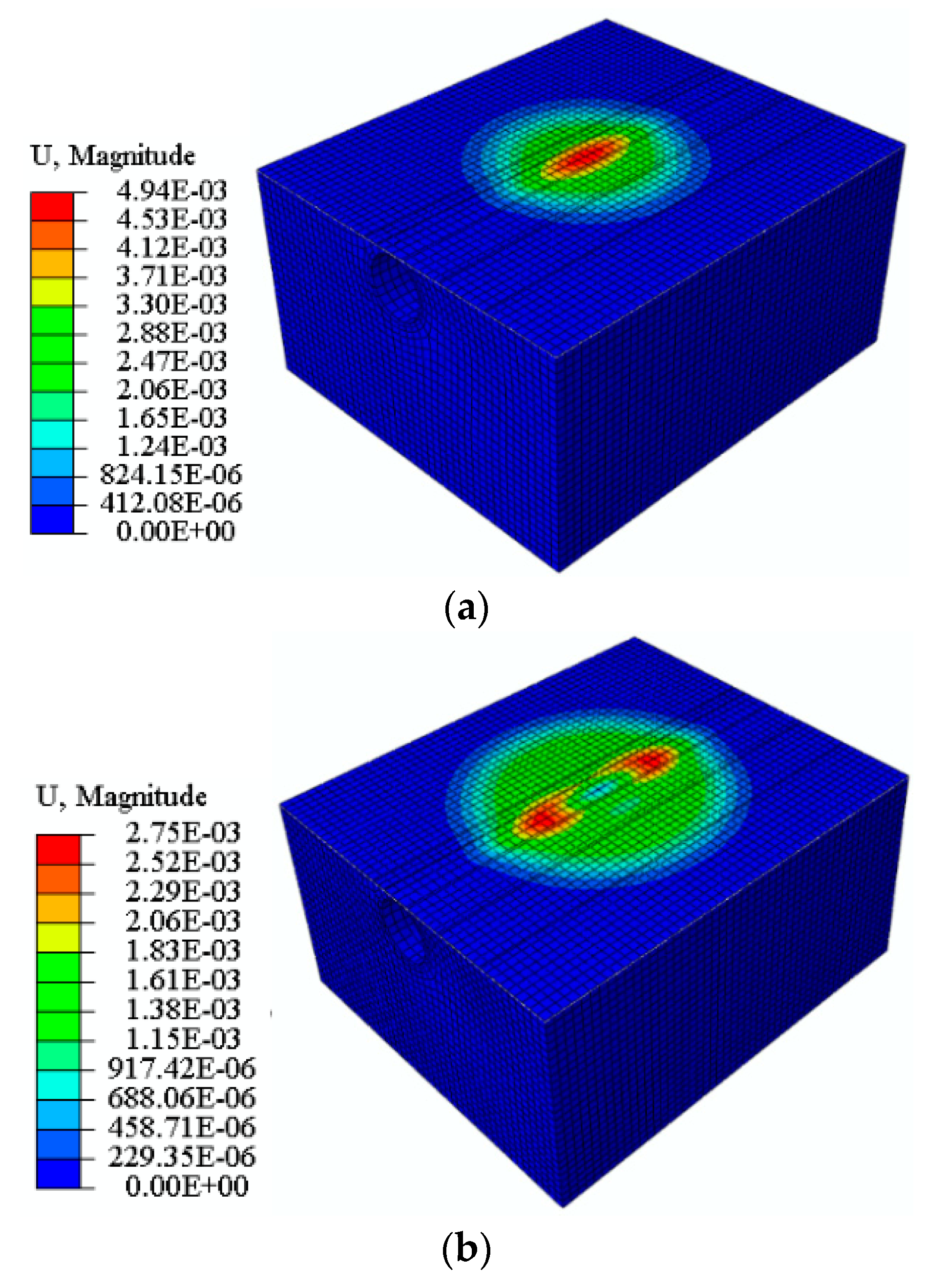
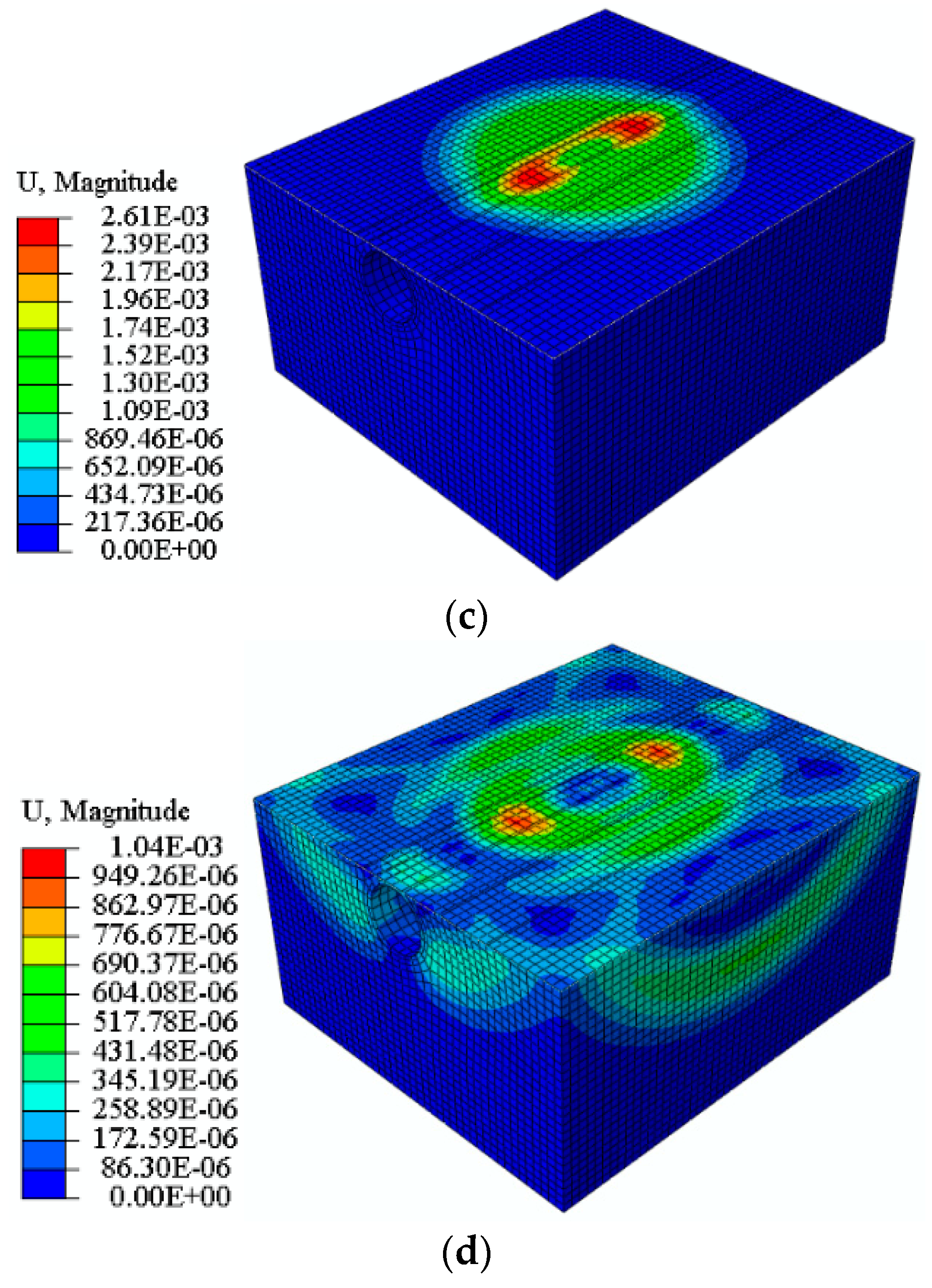

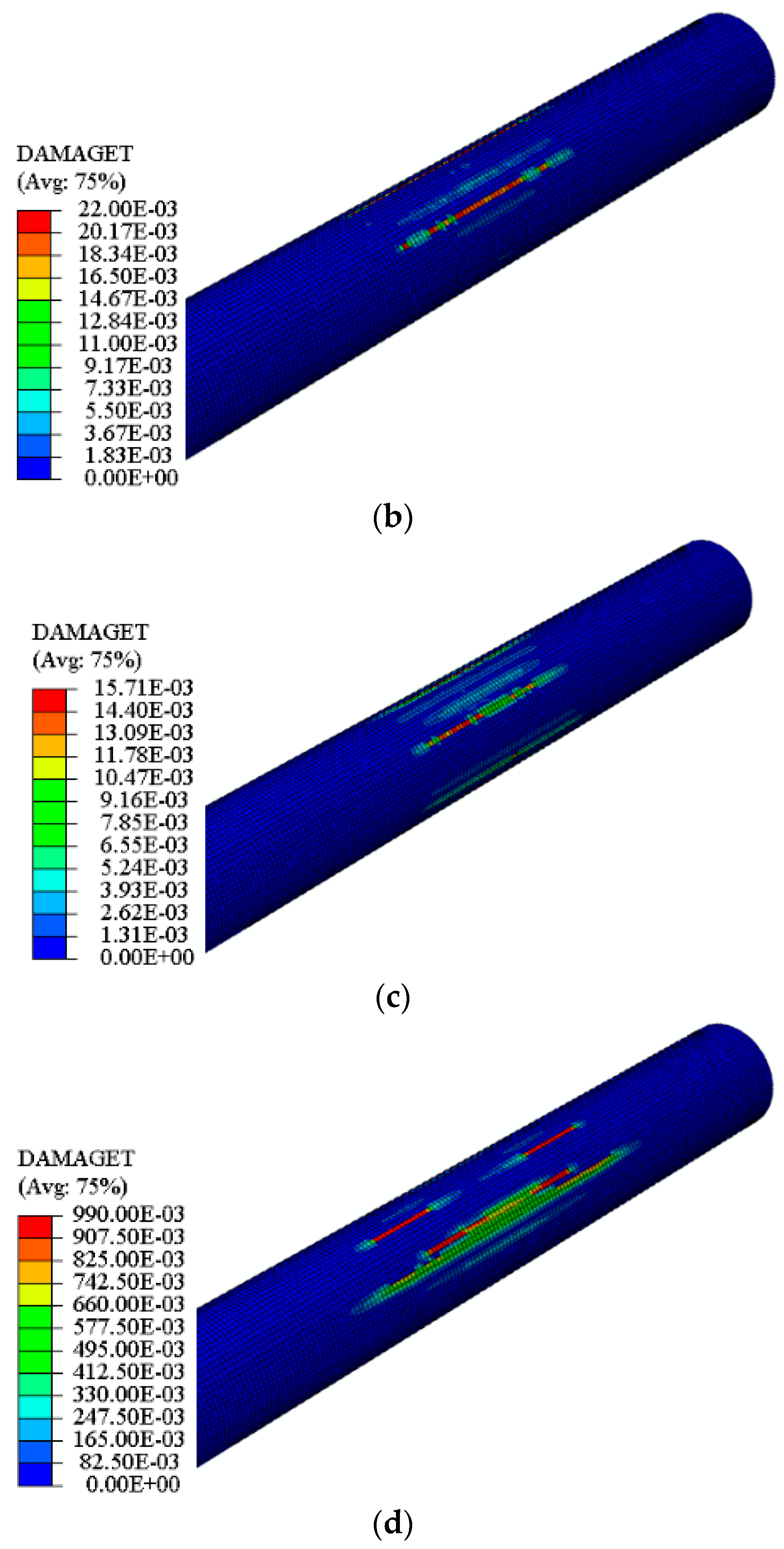
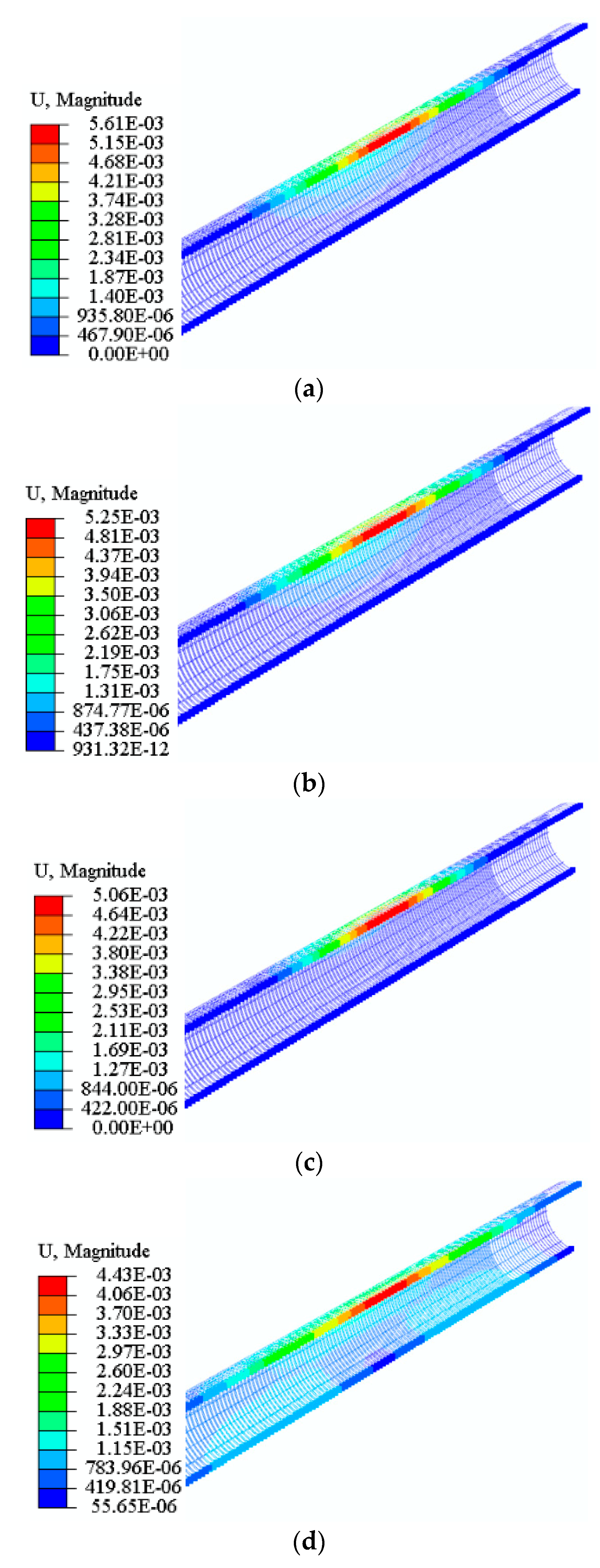
| Rock | Mass Density (kg/m3) | Young’s Modulus (GPa) | Poisson’s Ratio | Friction Angle (Degree) | Cohesion (MPa) |
|---|---|---|---|---|---|
| Jhingurda | 1670 | 2.84 | 0.25 | 21.34 | 3.68 |
| Singrauli | 2310 | 4.31 | 0.29 | 27.11 | 10.47 |
| Jamrani | 2480 | 5.29 | 0.22 | 37.79 | 11.17 |
| Kota | 2310 | 14.02 | 0.21 | 43.42 | 20.93 |
| (ρ) (kg/m3) | (E) (GPa) | (ν) | A (MPa) | B (MPa) | n | C | Rate (s−1) |
|---|---|---|---|---|---|---|---|
| 7850 | 200 | 0.33 | 490 | 807 | 0.73 | 0.0114 | 100 |
| Slab No. | Height (m) | Deformation (mm) | % Cent Error | |
|---|---|---|---|---|
| Experimental Study | FE Study | |||
| S4 | 1.0 | 46 | 44.39 | 3.5 |
| S5 | 1.5 | 63 | 61.74 | 2.0 |
| S6 | 1.5 | 50 | 47.00 | 6.0 |
| S8 | 1.0 | 60 | 57.00 | 5.0 |
| S9 | 1.2 | 61 | 59.17 | 3.0 |
| S10 | 2.0 | 77 | 73.15 | 5.0 |
Publisher’s Note: MDPI stays neutral with regard to jurisdictional claims in published maps and institutional affiliations. |
© 2022 by the authors. Licensee MDPI, Basel, Switzerland. This article is an open access article distributed under the terms and conditions of the Creative Commons Attribution (CC BY) license (https://creativecommons.org/licenses/by/4.0/).
Share and Cite
Alsabhan, A.H.; Sadique, M.R.; Alqarni, A.S.; Alam, S.; Suh, W. Behavior of Sedimentary Rock Tunnel against Rigid Projectile Impact. Appl. Sci. 2022, 12, 9595. https://doi.org/10.3390/app12199595
Alsabhan AH, Sadique MR, Alqarni AS, Alam S, Suh W. Behavior of Sedimentary Rock Tunnel against Rigid Projectile Impact. Applied Sciences. 2022; 12(19):9595. https://doi.org/10.3390/app12199595
Chicago/Turabian StyleAlsabhan, Abdullah H., Md. Rehan Sadique, Ali S. Alqarni, Shamshad Alam, and Wonho Suh. 2022. "Behavior of Sedimentary Rock Tunnel against Rigid Projectile Impact" Applied Sciences 12, no. 19: 9595. https://doi.org/10.3390/app12199595
APA StyleAlsabhan, A. H., Sadique, M. R., Alqarni, A. S., Alam, S., & Suh, W. (2022). Behavior of Sedimentary Rock Tunnel against Rigid Projectile Impact. Applied Sciences, 12(19), 9595. https://doi.org/10.3390/app12199595









